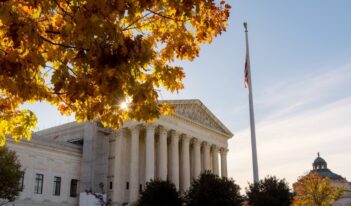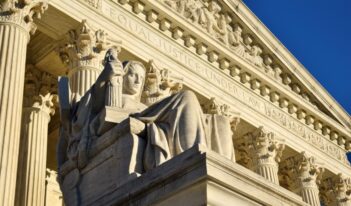
The unprecedented deference conferred by Department of Commerce v. New York sets the tone for cases to come.
In Department of Commerce v. New York, the U.S. Supreme Court seemed to put an end to the Trump Administration’s quest to include a citizenship question on the 2020 census, finding that the Secretary of Commerce’s proffered rationale was pretextual and then remanding the case back to the U.S. District Court for the Southern District of New York.
Nonetheless, the political firestorm over the citizenship question continued. Despite the U.S. Department of Justice and U.S. Secretary of Commerce Wilbur Ross initially stating that the 2020 census would move forward without the citizenship question, President Donald Trump tweeted two days later that the census would include a question about citizenship status. He called earlier reports to the contrary “fake news” and tweeted that the Administration would “do whatever is necessary to bring this most vital of questions, and this very important case, to a successful conclusion. USA! USA! USA!” But last week, President Trump reversed course, declaring that the question would not appear on the census after all.
Challengers to the citizenship question have argued that the attempt to include it on the 2020 census was politically motivated. They also asserted that the question would negatively impact the response rate and lead to population undercounts, particularly in already marginalized communities and communities of color—communities that trend toward the Democratic Party. Population counts derived from the census help determine government and private spending and investment decisions, as well as the allocation of congressional seats.
Proving that the decision to include a citizenship question was improperly motivated by politics has been at the center of the challenges. In the six different lawsuits initiated by states, municipalities, and non-governmental organizations, litigants fought over discovery requests intended to unveil those improper motives—while also trying to prove that including the citizenship question violated the Enumeration Clause of the U.S. Constitution, the Census Act, and the Administrative Procedure Act (APA).
Virtually on the eve of the Supreme Court’s decision, the New York challengers sought to stay that decision, at least temporarily, based on new evidence presented in the lower courts. This evidence purported to demonstrate that the decision to include the citizenship question originated with a political advisor, who identified it as a way to achieve redistricting in a manner that would benefit “Republicans and non-Hispanic whites.” The U.S. Court of Appeals for the Fourth Circuit had just remanded the consolidated Maryland challenges to the federal district court to determine whether the Fifth Amendment equal protection claim and the claim of interference with civil rights could move forward based on the new evidence obtained.
As the new evidence and associated arguments were being presented to the lower courts, The Supreme Court handed down its decision on the issues arising under the Enumeration Clause, Census Act, and APA.
Chief Justice Roberts, joined by Justices Alito, Gorsuch, Kavanaugh, and Thomas, went to great lengths to show that Secretary Ross’s decision to include the citizenship question in the 2020 census was supported by the evidence before him, and therefore, “within the bounds of reasoned decision-making” and within the Secretary’s discretionary authority under the APA.
The court unanimously dismissed the claims brought under the Enumeration Clause and Census Act, but disagreed about the reasonableness of the agency’s decision under the APA. The decision to use the census to obtain citizenship information contradicted the advice of the chief scientist of the U.S. Census Bureau and other experts, who urged against including the question because it would negatively impact the population count, and furthermore would obtain faulty data on citizenship.
Although Chief Justice Roberts was willing to grant near blanket discretion to the decision-making authority of Secretary Ross under the APA, he could not turn a blind eye to mendacity.
The Chief Justice outlined his narrow sense of the judicial review afforded to agency action under the APA, and ruled that a court “may not reject an agency’s stated reasons for acting simply because the agency might also have had other unstated reasons,” nor may it overturn an agency decision because “it might have been influenced by political considerations or prompted by an Administration’s priorities.” Instead, the Chief Justice held, only a “strong showing of bad faith or improper behavior” warrants an inquiry into “the mental processes of administrative decision-makers.”
While stating that the lower court’s order of extra-record discovery was “premature”—seemingly wishing away the evidence of dishonesty before him—the Chief Justice could not ignore the administrative record before him. In light of the “significant mismatch” that the Court confronted “between the decision the Secretary made and the rationale he provided,” the Chief Justice, joined by Justices Breyer, Ginsburg, Kagan, and Sotomayor concluded that the Secretary’s stated reasoning was “contrived” and, as such, warranted remand to the agency.
Even once the controversy over the 2020 census recedes into the distance, the Court’s decision in Department of Commerce v. New York holds open the door for extraordinary deference to the executive branch. Will the Chief Justice continue to lead the Court majority in drawing the line at the truth, as it seeks to uphold the integrity and independence of the judiciary? What evidence will it be willing to consider as it determines where that line should be drawn?
This Administration has systematically pushed the limits of the APA as it overhauls the immigration system and seeks to rewrite immigration law, while also regularly issuing anti-immigrant messages. As this Administration persists in separating immigrant families, detaining immigrants for prolonged periods of time without judicial review, denying individuals their right to seek asylum, and pursuing construction of a border wall without congressional approval of the funding of such a wall, these questions will certainly find their way back before the Court. In the term ahead, the Court will take up its review of Deferred Action for Childhood Arrivals (DACA). What deference will the Court afford to the Obama Administration’s original authority to enact DACA as compared to the Trump Administration’s authority to terminate it? Or will Congress finally act and render the appeal moot?
This essay is part of a series, entitled The Supreme Court’s 2018-2019 Regulatory Term.




